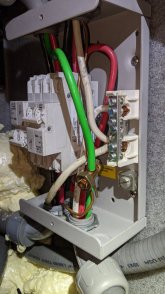GunTotnHippie
New Member
- Joined
- Jan 7, 2020
- Messages
- 17
I recently had a Victron Quattro 24v 8000 230v inverter die on me. I have contacted the vendor and now have to send the unit back. The inverter went into overload condition and I believe the PCB is now blown. The system is in a RV with 50amp connection. We decided to install an inverter bypass using a midnite solar transfer switch. The only thing I can figure is that when the switch is switched to bypass the 120v is back-feeding back into the Auto Transformer which was then back-feeding to the inverter. I could have also received a bad unit but the problem didn't start to happen until I was swapping out a battery in the bay and I think the DC wire may have moved the transfer switch to bypass. I am now trying to create a new bypass switch as the tolerance of the midnite solar switch is not very good and therefor allowing the breakers to be on or off at the same time (Bad design). The attached diagram shows the circuit in the bottom right hand corner. Does anyone know of a way to do a bypass with a rotary/cam switch or another option? The idea here is to have a single switch so it doesn't confuse anyone trying to work on the system.







